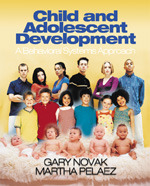Child and Adolescent Development
A Behavioral Systems Approach
- Gary Novak - California State University, Stanislaus
- Martha Pelaez - Florida International University, Miami, USA
`The book is a very good read. It is also truly unique in the field of developmental psychology…a field in which far too little attention is typically paid to the obvious fact that children's development involves learning' - Michael W. Vasey, The Ohio State University
`Presents behavioral principles in a systematic and fairly sophisticated manner (as contrasted with the simplistic treatment those principles often receive in textbooks of introductory or developmental psychology), while linking up with contemporary conceptions of dynamic systems. . . straightforward and clear, accessible to undergraduates without coming across as simplistic' - Philip N. Hineline, Temple University
`Most useful for the subset of college instructors who are process oriented and focus upon a sophisticated multilevel conceptual approach that considers the environmental impact on behavioral development and the concurrent impact of the developing individual upon the significant figures in its environment. . . . No other undergraduate text presents such a clear interweaving of developmental considerations and concepts with learning concepts' - Jacob L. Gewirtz, Florida International
`This book is unique because of its blending of behavior analysis and its dynamical systems point of view. . . . The authors' writing style is very engaging and accessible to undergraduate level students [and] the level of scholarship is excellent, particularly in its depth when dealing with theoretical issues. . . . A cutting-edge look at a behavior analytic view of child and adolescent development' - Pete Peterson, Johnson County Community College
There are two fundamental questions in developmental psychology – what develops and how does it develop? The "what" is largely a question of developmental structure and describes development, while the "how" is primarily a question of function or process and explains development. Developmental psychology has become increasingly focused on the process aspect, but many texts do not provide readers with a clear perspective of how development actually occurs.
Child and Adolescent Development: A Behavioral Systems Approach integrates the views of dynamical systems concepts with a behavioral view of development. This combination of perspectives is unique and from it something new emerges – "a behavioral systems approach" to development. It is an approach that incorporates both personal and environmental influences and the constant reciprocal interactions between nature and nurture.
The book emphasizes learning as the major process for change in development and the integration of environmental influences with genetic and historical factors. Authors Gary Novak and Martha Pelaez provide a coherent understanding of the learning process in childhood and adolescence and present successful interventions to minimize typical problematic behavior during this period.
"The book very nicely incorporates behavior analysis and modern developmental theories. . . . Another nice feature is that it is not encyclopedic; it organizes the disparate developmental phenomena in terms of principles and mechanisms. . . . The writing style is easy to follow and suitable for college students. The scholarship and coverage are excellent."
"The book is a very good read. It is also truly unique in the field of developmental psychology…a field in which far too little attention is typically paid to the obvious fact that children’s development involves learning."
"Presents behavioral principles in a systematic and fairly sophisticated manner (as contrasted with the simplistic treatment those principles often receive in textbooks of introductory or developmental psychology), while linking up with contemporary conceptions of dynamic systems. . .straightforward and clear, accessible to undergraduates without coming across as simplistic."
"Most useful for the subset of college instructors who are process oriented and focus upon a sophisticated multilevel conceptual approach that considers the environmental impact on behavioral development and the concurrent impact of the developing individual upon the significant figures in its environment. . . . No other undergraduate text presents such a clear interweaving of developmental considerations and concepts with learning concepts."
“This book is unique because of its blending of behavior analysis and its dynamical systems point of view. . . . The authors’ writing style is very engaging and accessible to undergraduate level students [and] the level of scholarship is excellent, particularly in its depth when dealing with theoretical issues. . . . A cutting-edge look at a behavior analytic view of child and adolescent development."
Reviewed behavioural development across the lifespans linking the child psychology theorists
An excellent research guide for level 6, Masters & PhD students. A complex but diverse book for all aspects of child development. Very rich in detail and research, an excellent resource!
always good to have such well written back ground reading
The students on my course require a more practically focussed textbook. This is a textbook with very little application of theory and practice and so would not be suitable. It is probably more suited to a non-vocational course looking at child and adolescent development.
A valuable book that will support students to meet thier development module





